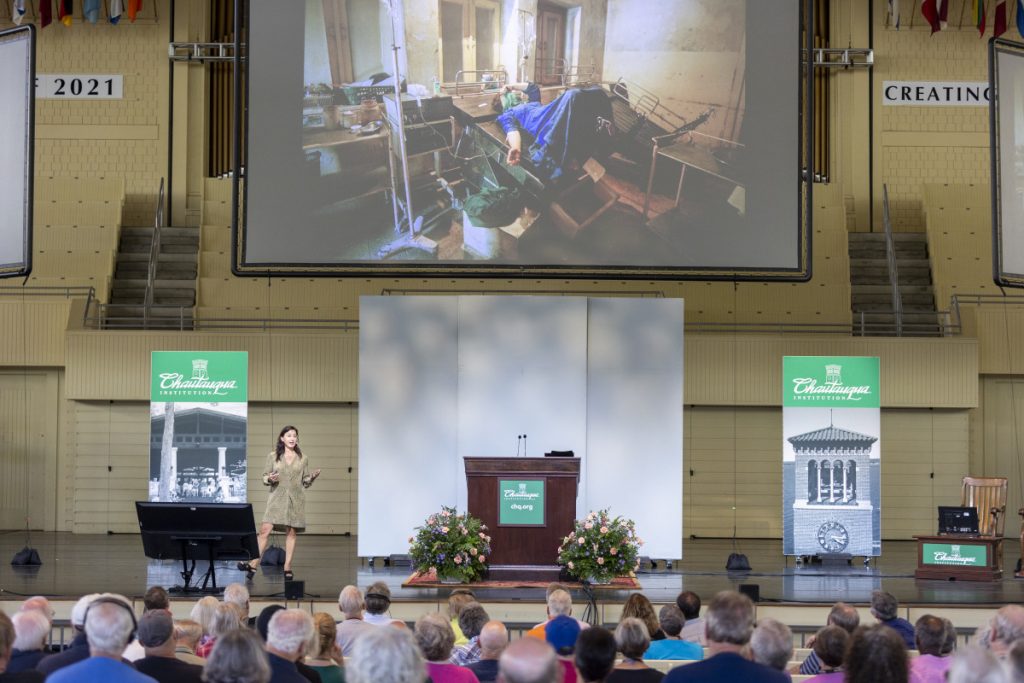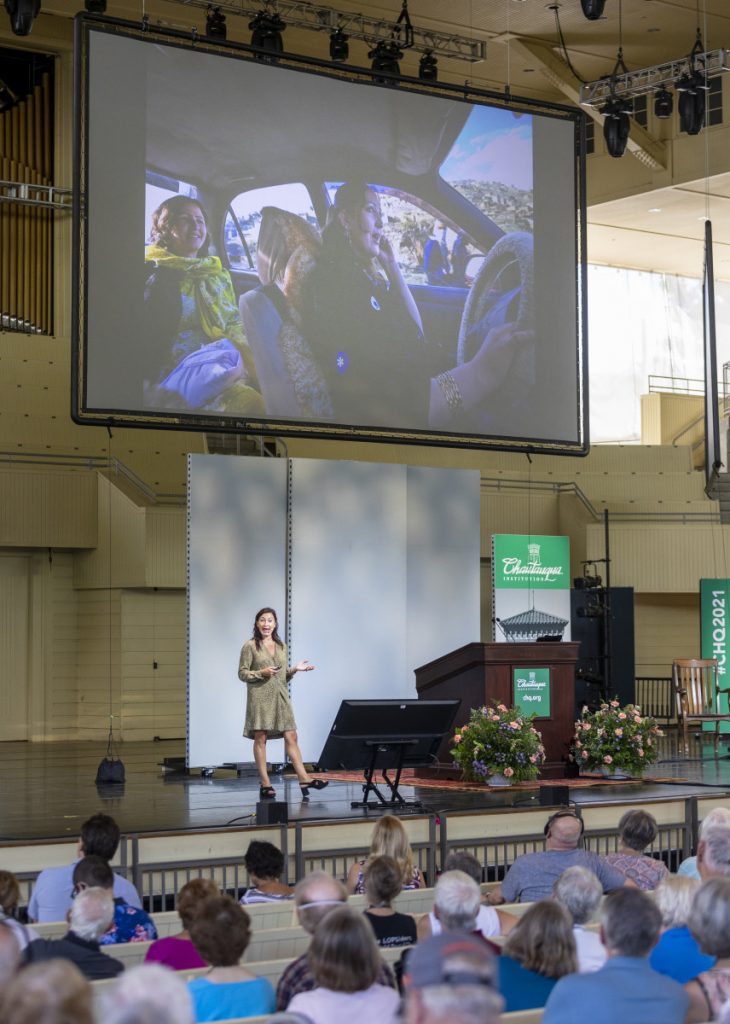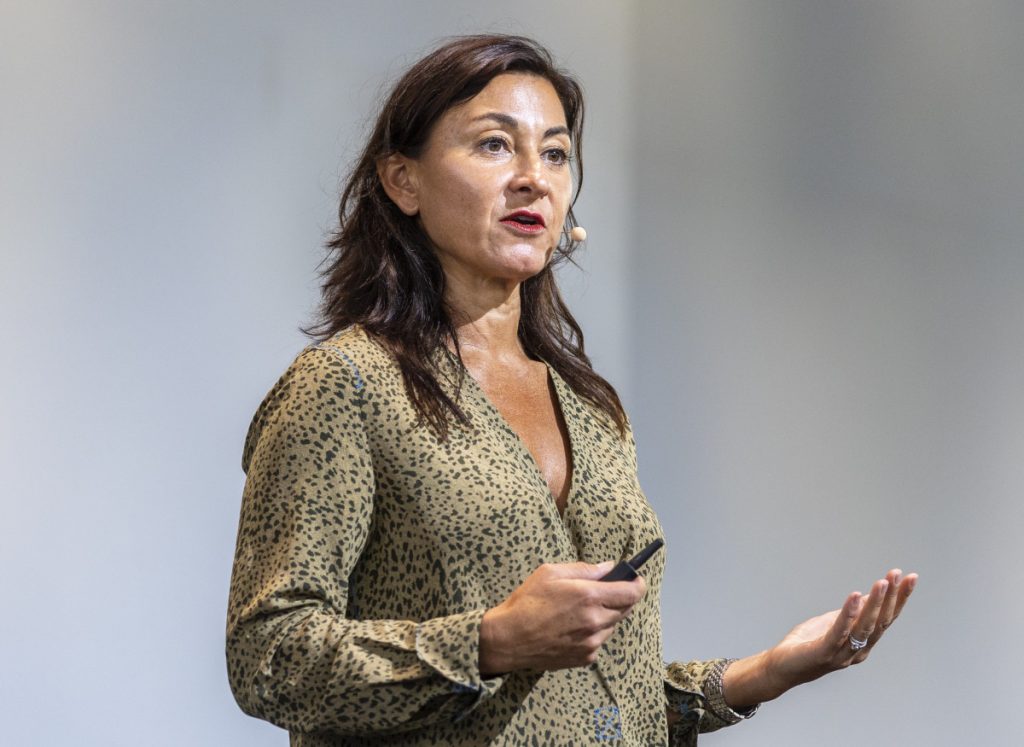NICK DANLAG – STAFF WRITER

Before 9/11, most of the U.S. did not know anything about Afghanistan, including Lynsey Addario’s mom, so when the young photojournalist let her mother know she was going there in 2000, her mom simply said, “Sure, have a good time.”
What Addario, now a Pulitzer Prize winner, didn’t tell her mother was that she would be photographing the lives of women under Taliban rule, where photography was illegal. She had an escort of Afghan men who kept her safe and her work a secret.
“Some of the first women that I saw on the streets, actually the only women I saw on the street, were widows,” Addario said. “They were begging because they had no man to provide for them.”
Addario would have to swiftly take her camera out of her bag, take photos and hide the camera again each time she saw a photo worth taking. Some of these images projected on the Amphitheater screens above her, from secret schools for young girls to a woman giving birth in a hospital in Kabul with what Addario described as “rudimentary” equipment.
During her third trip to Afghanistan under Taliban rule, Addario’s taxi driver said he was going to a wedding, and she asked to join him. He agreed and led her to a basement of a big cement compound. The soundtrack of “Titanic” blasted, and women, in makeup and dresses, danced.
“I had never seen anything like this in three trips to Afghanistan under the Taliban,” Addario said. “It just made me realize that the human spirit continues on, and people really have to find forms of entertainment to keep themselves going.”
At 10:30 a.m. Aug. 23 in the Amp, Addario presented her lecture, “It’s What I Do: Documenting Resilience,” to begin the Chautauqua Lecture Series Week Nine theme of “Resilience.” Addario told of her own journey of covering wars and her own kidnappings, how journalism and photography can change public perceptions and political wills, and the endless perseverance of the many people she has met over the years. Addario is a regular contributor for National Geographic, The New York Times and Time. Her New York Times best-selling memoir It’s What I Do: A Photographer’s Life of Love and War was a finalist for the 2016 Chautauqua Prize, chronicling her personal and professional life as a photojournalist in the post-9/11 world. She also published Of Love & War, a collection of photographs from the Middle East, South Asia and Africa.
Addario went back to Afghanistan in 2009 and saw progress in the country. Women were graduating from a school of literature, hosting news shows, working as police and soldiers and driving cars. In 2009, though, the country had the highest maternal death rate in the world; the Badakhshan province had an even higher rate because there were few roads to travel by. She said it took some people 12 hours by donkey to get to the nearest clinic. One day in Badakhshan, Addario saw two women on the side of the road and knew “they were in trouble because they didn’t have a man (with them).”
One of the women was in labor and refused to get in the car with Addario because she needed her husband’s permission first to get in someone’s car. Addario asked one of her coworkers to take the car and find the woman’s husband — which she said wasn’t hard, because there was only one road. She then got the whole family in the car, and the baby was delivered safely in the clinic.
Addario also talked about girls who had defied their husbands. One girl was 13 and married to a man who was paralyzed; her only duty in life until she was 20 was to take care of him. When she asked for a divorce, the man’s family threw her in jail. Another girl, identified only as Bibi Aisha, ran away from her husband, and when she was caught, her husband cut off her nose and ears. She was later featured on the front page of The New York Times before she underwent surgery to have her nose and ears reconstructed.
And Addario’s first experience covering wars was during the Iraq War. She photographed people celebrating Saddam Hussein’s fall from power.
“I took these initial pictures of euphoria: People celebrating, swimming in his palaces,” Addario said. “Saddam had diverted most of the water in the country for his own personal use, lakes around his palaces, and most Iraqis didn’t even have water at home.”
There was also a lot of chaos and looting after Hussein’s death; Addario showed a photo of a woman walking toward a factory covered in smoke. It was a propane factory where her husband worked. Addario took the picture, then yelled to the woman that it was too dangerous to go close. The woman turned, looked at her, and said, “My husband is in there.” She kept walking.

She also photographed wounded U.S. soldiers. She witnessed and photographed the treatment of one particular soldier who had stepped on an IED, and later died. She was told she could not call the family to get permission to publish the photos. A few months later, she received a call from the soldier’s father, who asked her about his son’s death because the military had told him next to nothing.
“We had a, maybe, two-hour-long conversation. It was very tearful on both sides. I told him everything I remembered,” Addario said.
The father later gave her permission to publish the photos, so long as they wouldn’t compromise his son’s identity.
Addario told the story of her kidnapping in March 2011 in Libya. The Libyan government was not giving journalists visas to photograph the Civil War, so Addario snuck in through a river with a rebel army. When she was in the town of Ajdabiya, she, along with three other New York Times journalists, could see signs that the city was about to fall. Sounds of mortars were getting closer, dictator Moammar Gadhafi’s troops were closing in and civilians were fleeing. They had two cars, with two journalists in each car in case something went wrong.
“The driver of the other car — his brother was shot at the front line,” Addario said. “And so suddenly in the middle of the battle, he pulled the car over and dumped everything they had on the side of the road, and said, ‘I’m leaving.’ ”
While they were leaving, Addario was the first to see the soldiers on the horizon. When she pointed them out, her companions laughed, because Gadhafi’s troops were in the other direction. But they were wrong, and the soldiers had flanked them in the desert. The driver panicked, stopped the car, got out and begged the soldiers not to shoot them because they were just journalists.
They never saw him again.
“My colleagues were pulled out of the car. I, the only woman, was just left to sit in the car. That happened to me, actually, when I was kidnapped in Iraq in 2004; I guess they never really know what to do with a woman on the front line,” Addario said. “I’m watching my colleagues to the right getting roughed up.”
The rebel soldiers then opened fire on the government soldiers.
“There was a wall of bullets coming at us. The car we were in was not armored. I knew I had to get out of the car,” Addario said. “I made the decision to lie down and crawl out the right side of the car toward my colleagues. Immediately, there was one Gadhafi’s troops on me, pulling at my cameras and, instinctively, I’m pulling back.”
Addario then realized she needed to let go of the camera, and both the journalists and troops all ran to the other side of a cement building. The government soldiers accused them of being spies and held a rifle to each of their heads.
“They put us down in the dirt,” Addario said. “We stared down, literally, the barrel of the rifle and begged for our lives. I remember looking to the right and seeing us all begging, and I, myself, was begging, ‘Please don’t shoot.’ Eventually, a commander came over and said, ‘You can’t shoot them, they’re American.’ ”
The four of them were then tied up and put in the back of a vehicle, “packed like sardines.”
“With my experience with war, I assume this is where they take me to rape me and, so, I just said ‘Please don’t hurt me,’ ” Addario said. “A soldier came up, punched me in the face and then they left us sitting on the front line for hours. For the first three days, we were all beaten, tied up, blindfolded, threatened with execution, repeatedly, and terrified, and this went on. I, the only woman, was groped. I was not raped, fortunately.”
Gadhafi later let them go free because he wanted to show the world he was a legitimate leader. The New York Times later sent a team to investigate what happened to the driver, but he was never found.

Later, Addario worked in Sudan, covering the civil war in the country. On a small island, she met a 12-year-old boy, Chuol, who had seen his father burned alive by Sudanese government soldiers who were raiding his home. Chuol had jumped into the water with his grandmother and sister, and the three lived off of lily pads for two months, until they met Addario. Chuol was the man of the family, so it was his responsibility to take care of his grandmother and sister while going to a UNICEF school. The family’s goal was to get to Kenya so Chuol could pursue an education. Chuol, his sister and his grandmother did not know what happened to Chuol’s mother and other siblings.
Addario tried to find her but only knew her name and village. Six months later, she got an assignment for a different publication to go to Lair — where Chuol was originally from — and realized his mother might be there.
“So I went to Lair, and it was like killing fields,” Addario said. “There were skeletons everywhere and people had not eaten in months because there were no aid workers who had been providing to them.”
The next day, however, 17,000 people gathered for food from an aid agency. Addario doubted she could find Chuol’s mother in the crowd if she was there, but then a few of the workers said they found her. Addario approached the woman and asked her questions only Chuol’s mother would know the answers to. The woman knew them, and Addario realized she had found Chuol’s mother, and burst into tears.
Addario then met Chuol’s siblings and showed them the cover of the New York Times with a photo of their brother. Addario filmed a video of the family for Chuol — his mother told him not to come to them until he graduated and got his education. When Addario then visited Chuol and showed him the video, “he was stoic, and I said, ‘Chuol, what do you think?’ He said, ‘I must get educated.’ ”
As part of the Q-and-A session, Matt Ewalt, vice president and Emily and Richard Smucker Chair for Education, asked Addario about her experience with the Taliban, and her thoughts on its recent takeover of Afghanistan.
During her three trips to the country under Taliban rule, Addario saw how oppressed Afghan citizens were. She has been making a lot of appearances on TV news channels and was on CNN the morning of the lecture. In one article she published in The Atlantic on Monday, she wrote about a “very grim future” for women in Afghanistan.
“I have been trying to show people,” Addario said, “Afghans love their country. They’ve been so happy to rebuild it over the last 20 years, and no one is happy to have to leave, but it is really a matter of life and death for most of them.”
She keeps in touch with people who helped her during her reporting, including a translator who was trampled at the Kabul Airport.
“She lost control of her 2-year-old. She watched another baby get stepped on, and she doesn’t know if that baby is the baby who died on Saturday, but she’s super traumatized,” Addario said. “Everyone’s traumatized and really desperate, and so I am basically fielding those calls all day.”
Ewalt then asked Addario what keeps her going in her work, given she has seen the worst in humanity.
“Because I believe in it. I believe it’s important for issues to be documented. I believe it’s important for the international community to intervene when necessary. We’ve so many injustices, human rights abuses that go on in conflict and outside of conflict,” Addario said. “I think that good journalism holds people accountable.”




